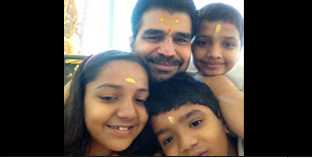Chapter 1:11 avasthitāḥ |bhīṣmam ēvābhirakṣantu bhavantaḥ sarva ēva hi Arrogant minds often doubt the brilliance or dedication of others. Duryodhana instructs his Kaurava army to protect Bhishma from
READ MORE
In today’s digital age, news coverage has become a vital aspect of our daily lives. With the rise of the internet and social media, news websites, platforms, and sources have proliferated, providing us with a wealth of information at our fingertips. Among these, Indian media has emerged as a significant player, offering a unique perspective on global and local news.
Indian news websites, such as The Hindu, The Times of India, and The Indian Express, have been at the forefront of news coverage, providing in-depth analysis and reporting on national and international events. These news sources have a strong presence in the country, with a vast network of correspondents and bureaus across the nation.
However, the Indian media landscape is not without its challenges. With the rise of social media, the traditional news sources have faced increased competition, leading to a shift in the way news is consumed and disseminated. News platforms like NDTV and Zee News have adapted to this changing landscape, offering a mix of traditional and digital news coverage.
Despite these challenges, Indian media has continued to evolve, with a growing emphasis on digital news and online platforms. News sites like NDTV.com and ZeeNews.com have become popular destinations for news and information, offering a range of features, including live updates, videos, and podcasts.
As the Indian media continues to adapt to the changing landscape, it is essential to understand the role it plays in shaping public opinion and influencing national and international events. This article will provide a comprehensive overview of news coverage from Indian media, examining the challenges and opportunities that lie ahead for this vital sector.
The Indian media landscape is a complex and dynamic entity, comprising a diverse range of news websites, news sites, and news sources. With the advent of digital technology, the way people consume news has undergone a significant transformation. Today, Indians have access to a plethora of news sources, both online and offline.
According to a recent report, India has over 100,000 registered news websites, with many more emerging every day. This proliferation of news sources has led to a situation where consumers are spoilt for choice. However, this abundance of options has also led to a situation where the quality of news has taken a hit. Many news websites and news sites in India are guilty of sensationalism, and the line between fact and fiction is often blurred.
The rise of online news sources has been a significant development in the Indian media landscape. With the advent of social media, news websites and news sites have been able to reach a wider audience, and the way people consume news has undergone a significant transformation. Today, many Indians get their news fix from online sources, and the popularity of news websites and news sites has led to a proliferation of online news sources.
However, the rise of online news sources has also led to concerns about the credibility of news. With the ease of publishing online, many news websites and news sites have emerged, but not all of them are credible. This has led to a situation where consumers are often left wondering what is true and what is not.
Despite the many challenges facing Indian media, there are many positive developments that are worth noting. For instance, the rise of online news sources has led to a greater diversity of voices and perspectives, and the way people consume news has become more interactive and engaging. Additionally, the proliferation of news websites and news sites has led to a greater emphasis on investigative journalism, and many news organizations are now focusing on in-depth reporting and analysis.
However, despite these positive developments, there are many challenges facing Indian media. For instance, the rise of online news sources has led to concerns about the credibility of news, and the proliferation of news websites and news sites has led to a situation where the quality of news has taken a hit. Additionally, the Indian media landscape is also plagued by issues such as sensationalism, and the line between fact and fiction is often blurred.
In conclusion, the Indian media landscape is a complex and dynamic entity, comprising a diverse range of news websites, news sites, and news sources. While there are many challenges facing Indian media, there are also many positive developments that are worth noting. As the media landscape continues to evolve, it is essential that news organizations prioritize quality and credibility, and that consumers remain vigilant in their pursuit of accurate and reliable information.
In India, the media landscape is diverse, with a wide range of news sources catering to different segments of the population. News coverage in Indian media can be broadly categorized into several types, each with its unique characteristics and target audience.
Print Media: Newspapers and Magazines
Print media is one of the most traditional forms of news coverage in India. Newspapers like The Hindu, The Times of India, and The Indian Express, as well as magazines like India Today and Outlook, provide in-depth coverage of national and international news. These publications have a wide readership and are considered to be among the most credible sources of news in the country.
Electronic Media: Television and Radio
Electronic media, including television and radio, is another significant source of news coverage in India. News channels like NDTV, CNN-IBN, and Times Now, as well as radio stations like All India Radio, provide breaking news and analysis to a large audience. These channels have a significant following and are known for their in-depth coverage of current events.
Online Media: News Websites and Social Media
The rise of the internet and social media has given birth to a new breed of news sources in India. News websites like The Quint, Scroll, and The Wire, as well as social media platforms like Facebook and Twitter, have become important sources of news and information. These online sources are known for their in-depth analysis and investigative reporting, and have a significant following among the younger generation.
Regional Media: News Sources in Regional Languages
India is a diverse country with 22 officially recognized languages. News sources in regional languages, such as Malayalam Manorama, Telugu Prajasakti, and Marathi Lokmat, cater to the specific needs of different regions and languages. These sources are an important part of the media landscape in India, providing news and information to a large audience.
Specialized Media: Business, Sports, and Entertainment News
In addition to general news coverage, there are several specialized media sources in India that focus on specific areas of interest. Business news sources like Business Standard and Mint, sports news sources like ESPN and Sports Illustrated, and entertainment news sources like Bollywood Hungama and Rediff, cater to the specific needs of different audiences.
In conclusion, the Indian media landscape is diverse and complex, with a wide range of news sources catering to different segments of the population. From print media to online media, and from regional media to specialized media, each type of news coverage has its unique characteristics and target audience.
The Indian media landscape is complex and dynamic, with a plethora of news sources, news sites, and news websites vying for attention. However, despite the abundance of options, Indian media faces numerous challenges that impact its ability to deliver quality news to the masses. Here are some of the key challenges faced by Indian media:
1. Competition and Fragmentation
2. Regulatory Challenges
3. Funding and Revenue Models
4. Digital Divide and Access
5. Fake News and Disinformation
6. Diversity latest news and Representation
7. Safety and Security
These challenges facing Indian media are significant and far-reaching, with implications for the way news is reported, consumed, and disseminated in the country. Addressing these challenges will require a concerted effort from news organizations, policymakers, and the public to ensure that Indian media remains a vibrant and independent force for good.
In today’s digital age, news coverage has become a crucial aspect of Indian media. With the rise of news sources, news sites, and news websites in India, it is essential to follow best practices to ensure the accuracy, credibility, and reliability of news coverage. Here are some best practices for news coverage in Indian media:
1. Verify Information: Before publishing any news, it is essential to verify the information. This includes cross-checking facts, verifying sources, and ensuring that the information is accurate and reliable. This is crucial in today’s digital age where misinformation can spread quickly.
2. Use Multiple Sources: Using multiple sources is essential to ensure the accuracy of news coverage. This includes using official sources, eyewitness accounts, and other credible sources to gather information. This helps to ensure that the news coverage is comprehensive and accurate.
3. Be Timely: News coverage in India is often time-sensitive, and it is essential to be timely in reporting news. This includes being the first to break a story, providing updates, and keeping readers informed about the latest developments.
4. Use Visuals: Visuals such as images, videos, and infographics can help to make news coverage more engaging and informative. This includes using high-quality images, videos, and infographics to illustrate news stories and make them more accessible to readers.
5. Be Transparent: Transparency is essential in news coverage. This includes being transparent about sources, methodology, and any potential biases. This helps to build trust with readers and ensures that news coverage is credible and reliable.
6. Use Social Media: Social media has become an essential platform for news coverage in India. This includes using social media platforms to share news, engage with readers, and provide updates. However, it is essential to be mindful of the potential risks and challenges associated with social media, such as misinformation and online harassment.
7. Respect Sources: Respecting sources is essential in news coverage. This includes respecting the privacy and security of sources, as well as being transparent about the sources used in news coverage. This helps to build trust with sources and ensures that news coverage is credible and reliable.
8. Be Objective: Objectivity is essential in news coverage. This includes being impartial, unbiased, and fair in reporting news. This helps to ensure that news coverage is accurate, credible, and reliable.
9. Use Data: Data is an essential tool in news coverage. This includes using data to illustrate news stories, provide context, and make news coverage more informative. This helps to ensure that news coverage is comprehensive and accurate.
10. Continuously Improve: Finally, it is essential to continuously improve news coverage. This includes continuously monitoring and evaluating news coverage, as well as seeking feedback from readers and sources. This helps to ensure that news coverage is accurate, credible, and reliable, and that it meets the needs of readers and sources.
No Schedules for this section.
No Schedules for this section.



